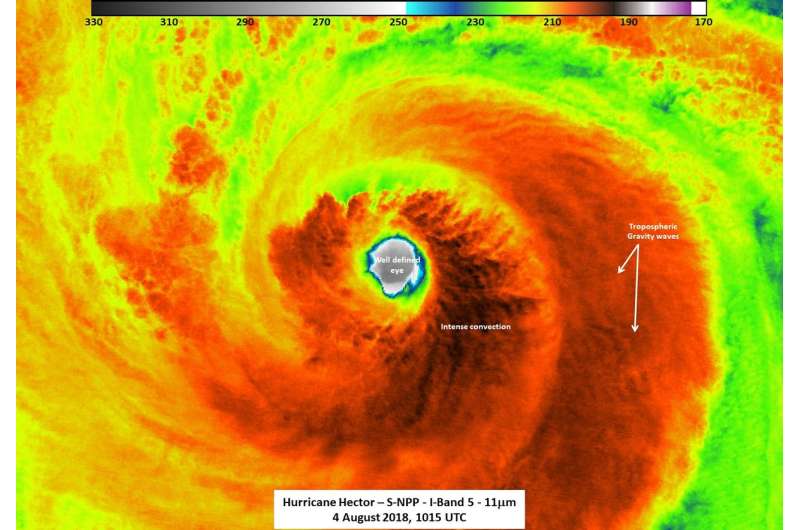The satellite of the Finnish nuclear power plant receives night and infrared views from Hurricane Hector
The VIIRS instrument of the Finnish nuclear power plant’s satellite flew over Category 3 hurricane Hector on August 4 at 0300 UTC (August 3 at 23:00 EDT) and took a picture of the storm tonight, which showed a clear eye in the moonlight. NOAA / NASA Goddard MODIS Rapid Reaction Team
Hurricane Hector was impressive in the night and infrared images taken from NASA-NOAA’s Finland NPP satellite when it intensified into a major hurricane. Hector recently crossed the eastern Pacific from the eastern Pacific and became a category 4 hurricane.
NASA-NOAA’s Finland NPP satellite provided forecasters with a night and infrared view of Hurricane Hector’s clouds on August 4 at 0300 UTC (August 3 at 11:00 PM EDT) when Hurricane Hector became a Class 3 hurricane. Hurricane Hector has maintained its strength with continuous 120 mph winds and an estimated average pressure of 962 millibars.
Images were taken by William Straka III of the University of Wisconsin-Madison, Madison, of the Cooperative Institute for Meteorological Satellite Studies (CIMSS) at the Madison Center for Space Science and Technology (SSEC). Straka said: “The Finnish nuclear power plant had almost the lowest overflow from Hector, which meant that the features of the storm were fairly well visible. It is not surprising that convection in the I05 channel, 11um.The last quarter of the moon (53% illumination) also provided enough moonlight to see convection in the feeding zones along with the cirrus blowing and the precisely delimited eye. it is very well defined and shows the open ocean. “

The VIIRS instrument of the Finnish nuclear power plant’s satellite flew Hurricane Hector Category 3 on August 4 at 0300 UTC (August 3 at 11 pm EDT). Peak cloud temperatures were close to 190 Kelvin / -117.7 F / -83.5 C in all quarters except north. Credit: UWM / SSEC / CIMSS, William Straka III
At 5.00 a.m. EDT at 11 p.m. (0900 UTC / or 11 p.m. HST on August 5), Hurricane Hector’s Center was located near latitude 14.9 north, longitude 140.6 west. It is about 1,010 miles (1,625 km) east of Hilo, Hawaii.
The maximum continuous wind speed is close to 140 mph (220 km / h) and higher in gusts. Hector is a Class 4 hurricane on the Saffir-Simpson Hurricane Wind Scale. Some fluctuations in intensity are expected tonight and Monday, followed by a gradual decline on Monday night to Wednesday, August 8th. The estimated average pressure is 947 millibars.
The Central Pacific Hurricane Center (CPHC) said Hector is moving west at about 15 mph (24 mph) and movement to the west-northwest is expected to increase forward until Tuesday, followed by movement west on Tuesday night through Friday. , August 10.
NASA’s Terra satellite finds powerful storms in Hurricane Hector
Quotation: Satellite of Finnish nuclear power plant receives night and infrared views from Hurricane Hector (2018, August 6) retrieved on 10.11.2021 at https://phys.org/news/2018-08-english-npp-satellite-night-time-infrared .html
This document is subject to copyright. Except for fair trade for private study or research, no part may be copied without written permission. The content is for informational purposes only.




